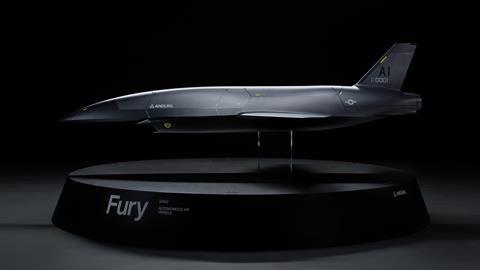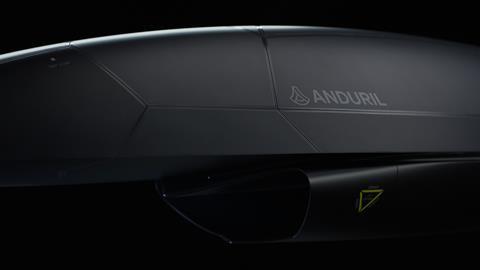US defence start-up Anduril is advancing development of the Fury autonomous fighter platform it acquired with the purchase of Blue Force Technologies in September.
California-based Anduril is best known for its Lattice autonomous integration software and small uncrewed aerial vehicles (UAVs), such as the Ghost and Altius.
But amid surging interest by the Pentagon in autonomous combat systems, the privately-held start-up expanded its portfolio into larger and more-capable jet aircraft with the acquisition of UAV developer Blue Force.
At Anduril’s Costa Mesa headquarters on 30 November, founder and chief executive Palmer Luckey told FlightGlobal the deal will allow Anduril to make Fury better.
“We’re bringing our own autonomy, we’re bringing our own communication stack,” Luckey says.

Anduril is also bringing experience in propulsion and composite materials to the Fury development effort. The company recently unveiled its new Roadrunner vertically-launched UAV interceptor, powered by two proprietary, internally-developed jet engines.
Fury is targeted at the Pentagon effort to produce a jet-powered UAV capable of supporting conventional crewed fighter aircraft. The US Air Force calls the concept Collaborative Combat Aircraft (CCA), while the US Navy and Marine Corps (USMC) use the name Penetrating Affordable Autonomous Collaborative Killer.
“It helps you do the things the manned aircraft don’t want to do, or they don’t want to risk their lives doing,” Luckey says of the autonomous fighter concept. “Pushing the line out beyond where you want the people to be… and not having to worry too much, particularly [about whether] it comes home.”
The Pentagon has said it hopes to begin delivering “multiple thousands” of low-cost autonomous systems within 18-24 months.
Anduril faces the challenge of taking on rivals with more mature CCA designs.
Both Kratos and Boeing already have flying prototypes, with Kratos having delivered multiple examples of its XQ-58 Valkyrie to the USAF and USMC for flight testing. Boeing’s MQ-28 Ghost Bat, developed in partnership with the Australian Defence Force, is undergoing flight testing in Australia and the USA.
Rather than develop a clean-sheet design, Anduril acquired North Carolina-based Blue Force, getting its hands on Fury and closing the development gap, says Luckey.
“It’s really a matter of timelines,” the tech industry billionaire adds. “There’s a window of opportunity to compete for these programmes… It was a more-schedule-efficient move and quality-efficient move to basically get a really big head start.”

Now Anduril is making changes to Fury’s design, with an eye toward expanding its operational scope.
While Blue Force envisioned the UAV as an adversary air platform used to help train US fighter pilots, Anduril is modifying Fury to serve as a fully operational CCA.
“There are changes to the airframe, to bring it away from the kind of [adversary-air] roll and to serve as a CCA,” Luckey says.
Anduril notes adversary air is still an intended use case for the Fury.
The air force intends to deploy CCA assets with the service’s planned sixth-generation fighter, currently known as the Next Generation Air Dominance (NGAD) programme. While little is known about the secretive effort, the service has said it hopes to select a prime contractor for NGAD sometime in 2024.
CCA systems will be developed in parallel with NGAD, filling a range of potential roles including electronic warfare, lethal fires support and aerial refuelling.
One aspect of the Fury design Anduril is keeping for now is the UAV’s single engine. Anduril declines to discuss engine details, but former Blue Force president Scott Bledsoe has said the aircraft will use a commercially available business jet engine. Bledsoe in 2022 said Blue Force was “working closely” with two engine suppliers, according to Forbes reports.
Luckey says Fury will let Anduril rapidly bring to market a viable aircraft – one superior to any aircraft Anduril or Blue Force could have produced alone.
“Blue Force built a really good team,” Luckey says. “They built a really good aircraft. The thing that’s going to come out of both of us is way better than [what] either of us would have done on our own,” he adds.


























